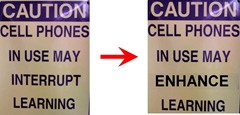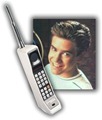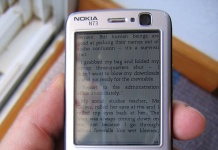 Audrey Watters of Read Write Web reports that the final version of the National Education Technology Plan (NETP), centered around improving educational uses of technology, calls for making sure that educators and students have 24/7 Internet access and for implementing policies that “enable leveraging the technology that students already have.”
Audrey Watters of Read Write Web reports that the final version of the National Education Technology Plan (NETP), centered around improving educational uses of technology, calls for making sure that educators and students have 24/7 Internet access and for implementing policies that “enable leveraging the technology that students already have.”
As Watters points out, the most ubiquitous technology among students is cell phones—more than 75% of kids between 12 and 17 own them, and a lot of schools have policies regulating or banning their use. Cell phones’ drawbacks include that they could distract from learning, contribute to cyberbullying, pose problems relating to the Children’s Internet Protection Act (3G iPhone Internet can bypass school net filters), and—though Watters’s article doesn’t mention this—be used for cheating on tests, in gang-related and criminal activity such as drug dealing, or in controversial “sexting” behavior.
But beyond crucial lessons in digital citizenship, cellphones can be a great (and low-cost) technology tool in the classroom. Cellphones are cameras and audio recorders, allowing students to work on multimedia projects. Cellphones are calculators. They are calendars – a far better way to record homework assignments than the print calendars students never carry around. Cellphones can be used to poll students in classrooms. In other words, cellphones can allow students to create and to share content, and they can provide an important bridge between the classroom and home.
And for that matter, some of them—smartphones such as the iPhone or Android models—are also able to read e-books, including books assigned as course reading. It might be easier to convince kids to read Dickens or Bronte if they can do so on their favorite pocket-sized gadgets. (I know it sure would have been easier to convince me. For that matter, I did read a lot of the Herodotus assigned during my college course on Greek history as a public-domain title on my Visor.)
Of course, not every high school student can afford a smartphone. (I’m an adult with full-time employment and I still can’t!) The NETP suggests a “Free Lunch” style program to give less-privileged kids access to better mobile devices. And, of course, net-enabled PDAs, tablets, laptops, and netbooks could also be useful.
 Back when I went to high school, chalkboards were the rule and about the only electronic devices that one could have on one’s person were considered “toys” and not allowed. (Cell phones? Hyperexpensive devices the size of a brick that only fictitious kids like Zack Morris from Saved By the Bell would have available.)
Back when I went to high school, chalkboards were the rule and about the only electronic devices that one could have on one’s person were considered “toys” and not allowed. (Cell phones? Hyperexpensive devices the size of a brick that only fictitious kids like Zack Morris from Saved By the Bell would have available.)
But now schools have fancy electronic multimedia Smart boards, Elmo document cameras, mobile computer labs, and who knows what else. Cell phones and other electronic devices are things kids grow up with, and life without them is the provenance of stories in books published decades ago. Kids use these for social networking, keeping up with their friends, and so forth—but even in the midst of these new technological classrooms, many schools are still regulating personal electronics as “toys”, or at least as distractions.
There are also legal issues relating to cell phone possession in schools (PDF), in part because of the possible criminal uses I brought up earlier. Some states have enacted laws regulating cell phones in schools, and national education groups have been in favor of banning them on safety and security grounds. Their place in classrooms has been a matter of much debate and discussion over the last decade and a half as their popularity and availability has grown. However, there are also a number of organizations and websites promoting and examining cell phones’ use in education, such as Cell Phones in Learning.
The NETP program may end up producing the kind of mobile-tech-enabled school I wish I could have attended at that age. And that will be a fascinating experience all around.
































Some students acknowledge problems caused by some students with the inappropriate use of a cell phone. However, they contend that the majority of students use the cell phone constructively while obeying all school rules.